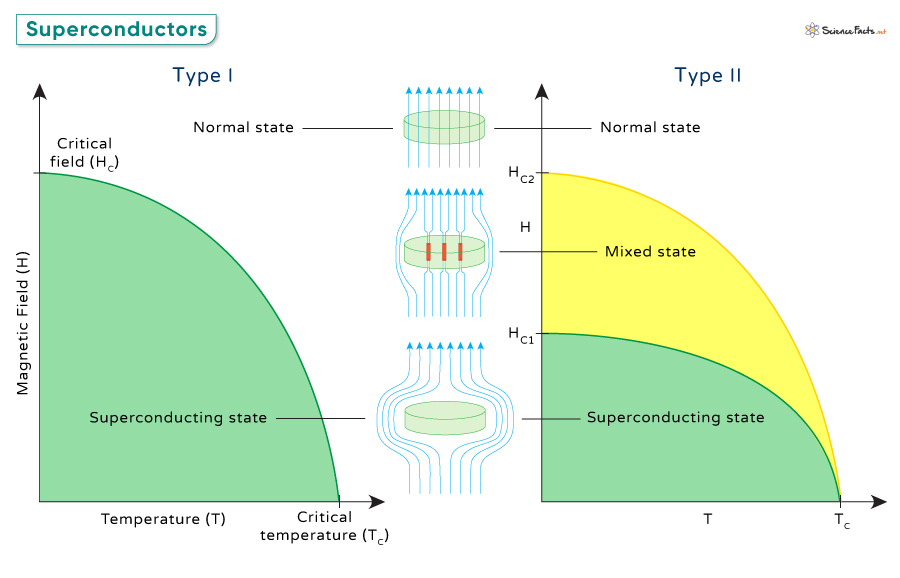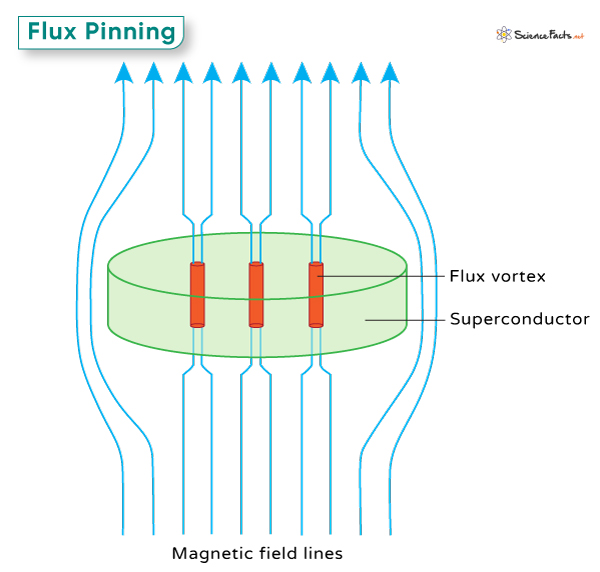Type I and Type II Superconductor
Superconductivity is a phenomenon observed in certain materials called superconductors. When cooled below a certain temperature, they exhibit zero electrical resistance and expulsion magnetic fields. They are divided into two main categories: Type I and Type II superconductors, each with distinct characteristics and behaviors.
Types I Superconductors
Type I superconductors are materials that can conduct electricity without any resistance when they are cooled below a certain temperature, known as critical temperature. When these materials are cooled below their critical temperature, they expel all magnetic fields from their interior, a phenomenon known as Meissner effect. They behave like diamagnets. Superconductivity stops once the applied magnetic field exceeds its critical magnetic field, and the material returns to a normal, resistive state.
Type I superconductors are typically elemental metals like lead and mercury.
The critical field for a Type I superconductor is temperature-dependent and can be described by the equation:
Where:
– HC(T) is the critical field at temperature T.
– HC(0) is the critical field at absolute zero temperature.
– T is the temperature of the superconductor.
– TC is the critical temperature at which the material becomes superconducting.
Type II Superconductors
Type II superconductors are a class of materials that also conduct electricity without resistance below their critical temperature. However, unlike Type I superconductors, they do not completely expel magnetic fields from their interior. Instead, they allow magnetic fields to penetrate through them in specific regions called vortices.
Vortices are tiny “tubes” of normal material surrounded by superconducting regions. Imagine a sponge soaked in water. The sponge (superconductor) has holes (vortices) where the water (magnetic field) can penetrate inside. It implies that the overall structure of the sponge remains intact, with the existence of specific regions where the normal (non-superconducting) state exists.
Type II superconductors have two critical magnetic field values: a lower critical field (Hc1) and an upper critical field (Hc2). Below Hc1, they behave like Type I superconductors and expel all magnetic fields (Meissner effect). Above Hc2, they lose their superconducting state entirely and become normal conductors. Between Hc1 and Hc2, they enter a region known as “mixed state”, where the vortices form but still retain their superconducting properties.
Type II superconductors include high-temperature superconductors like YBCO (yttrium barium copper oxide) and many niobium-based alloys.
Flux Pinning
Flux pinning is a phenomenon observed in Type II superconductors where magnetic flux lines are trapped within the material. This occurs because the superconductor contains structural defects, impurities, or grain boundaries that create regions where the vortices can become anchored. When an external magnetic field is applied, these vortices become trapped in these weaker areas, preventing their movement. This stabilization of the vortices helps the superconductor maintain its zero electrical resistance, even in the presence of an external magnetic field.
Differences Between Type I and Type II Superconductors
The key differences between Type I and Type II superconductors lie in their magnetic properties and critical field strengths. Below is a table summarizing these differences.
| Feature | Type I Superconductors | Type II Superconductors |
|---|---|---|
| Critical Temperature (Tc) | Relatively low, usually below 10 K | Relatively high, can range from 10 K to over 100 K |
| Critical Magnetic Field (Hc) | Low, typically up to a few hundred Gauss | High, ranging from thousands to tens of thousands of Gauss |
| Magnetic Flux Expulsion | Complete expulsion of magnetic fields (Meissner effect) | Incomplete expulsion, some magnetic flux penetrates the material |
| Meissner Effect | Perfect | Imperfect |
| Superconducting State Stability | Low, susceptible to magnetic flux penetration and sudden transitions | High, more resistant to magnetic flux penetration and stable transitions |
| Multiple Transitions | Not observed | Can undergo multiple phase transitions with changing magnetic field |
| Applications | Low-power applications such as sensors and superconducting cables | High-field applications, including MRI machines and superconducting magnets |
| Examples | Lead and mercury | YBCO (yttrium barium copper oxide) and niobium-based alloys |
-
References
Article was last reviewed on Tuesday, August 6, 2024









